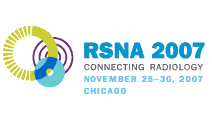
Abstract Archives of the RSNA, 2007
SSA01-05
MRI Detected Breast Lesions of 5 mm or Less in Size: Variables That Influence the Likelihood of Malignancy
Scientific Papers
Presented on November 25, 2007
Presented as part of SSA01: Breast Imaging (MR Imaging)
Bruce L. Daniel MD, Abstract Co-Author: Nothing to Disclose
Maurice A. van den Bosch MD, PhD, Presenter: Nothing to Disclose
Fred M. Dirbas, Abstract Co-Author: Nothing to Disclose
Debra Masako Ikeda MD, Abstract Co-Author: Nothing to Disclose
To assess the prevalence of cancer in patients with MRI-only breast lesions ≤5mm in size and to identify MRI characteristics that are related to malignancy.
We retrospectively reviewed data of 54 patients with 57 MRI-detected suspicious breast lesions ≤5mm in size who underwent MRI-guided needle localization and surgical biopsy at our institution between 1998 and 2005. Indications for MRI of the breast included high risk screening (n=9), suspicious clinical findings (n=12), indeterminate findings on conventional imaging (n=12), and staging of known breast cancer (n=21). Breast lesion morphology and enhancement kinetics were scored and categorized according to the ACR BI-RADS-MRI lexicon criteria. In all cases MRI findings were correlated with pathology.
Size of 57 breast lesions on MRI varied from 2 to 5mm. Analysis of lesion morphology according to the BI-RADS-MRI lexicon criteria revealed oval smooth margins in 26 (46%), round smooth margins in 21 (37%), irregular margins in 5 (8%), lobulated margins in 3 (5%), and spiculated margins in 2 (4%) cases. Kinetic enhancement curves of the 57 lesions were coded as benign in 10 (18%), indeterminate in 14 (25%), and suspicious in 25 (44%) cases, in 8 (13%) lesions curve analysis was not possible due to their small size. Histopathologic analysis showed 19/57 malignancies (33%). The other 38 lesions proved to be 6 high risk lesions and 32 benign lesions. Although, no morphologic features significantly differentiated between benign and malignant small breast lesions, all 19 malignancies presented with abnormal enhancement kinetics, i.e. indeterminate in 6 or suspicious in 10 (in 3 lesions analysis of enhancement kinetics was not possible due to small size).
In our study, the overall percentage of malignancies in the group of MRI-detected breast lesions ≤5mm was 33%. Our findings indicate the importance of kinetic enhancement curves analysis when evaluating small ≤5mm breast lesions on MRI, since all malignancies presented with abnormal enhancement kinetics.
It would be clinically relevant to identify the subgroup of patients with small MRI-detected breast lesions in which biopsy is warranted.
Daniel, B,
van den Bosch, M,
Dirbas, F,
Ikeda, D,
MRI Detected Breast Lesions of 5 mm or Less in Size: Variables That Influence the Likelihood of Malignancy. Radiological Society of North America 2007 Scientific Assembly and Annual Meeting, November 25 - November 30, 2007 ,Chicago IL.
http://archive.rsna.org/2007/5011472.html

